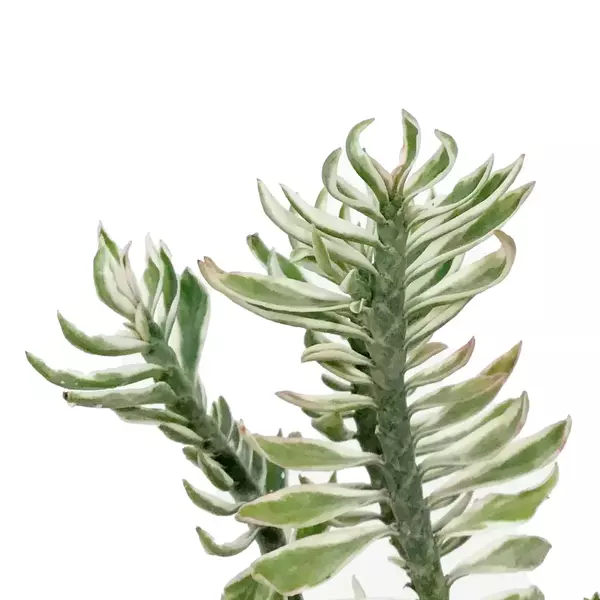Selling Size: Single plant | 2.5″Pot Included | Secure Packing
The Variegated Dwarf Devil’s Backbone, scientifically known as Euphorbia tithymaloides (often specifically subsp. smallii ‘Variegata’ or ‘Nana Variegata’), is a popular and relatively easy-to-care-for succulent. Its distinctive zigzag stems and striking variegated leaves (green with white, cream, pink, or red edges) make it a visually appealing addition to any plant collection.

Here’s a comprehensive guide care for euphorbia tithymaloides:
1. Light:
- Bright, indirect light to full sun is ideal. This plant thrives with ample light, which helps maintain its vibrant variegation and compact growth.
- It can tolerate some direct morning sun, but gradual acclimation is necessary to prevent sunburn, especially for outdoor plants in hot climates.
- Insufficient light can lead to leggy growth and less pronounced variegation.
2. Watering:
- Water thoroughly when the soil is completely dry to the touch. As a succulent, it’s drought-tolerant and prone to root rot if overwatered.
- During the active growing season (spring and summer), you’ll water more frequently, but always allow the soil to dry out between waterings.
- Reduce watering significantly in the fall and winter when growth slows down.
- Signs of underwatering include crispy/curling leaves, a gray, washed-out appearance, and yellowing leaves. Overwatering can cause yellowing lower leaves, stunted growth, and mushy stems or roots.
3. Soil:
- Well-draining soil is crucial. A cactus or succulent potting mix is highly recommended.
- You can create your own by mixing one part cocopeat, one part sand, and one part garden soil, with compost for added nutrients. Adding perlite or pumice will further improve drainage and aeration.
- It prefers a soil pH between 6 and 7.5 (neutral to slightly acidic).
4. Temperature and Humidity:
- Warm temperatures are preferred. Ideal temperatures range from 60-85°F (15-30°C).
- It can tolerate temperatures as low as 50°F (10°C), but it’s best to bring it indoors if temperatures consistently drop below this, especially during early winter.
- Protect it from frost.
- Average to high household humidity is generally well-tolerated. It doesn’t require high humidity and should not be misted.
5. Fertilizer:
- Feed with a balanced, diluted fertilizer during the growing season (spring and summer).
- Avoid fertilizing during the dormant period (fall and winter).
6. Repotting:
- Devil’s Backbone plants often prefer to be somewhat root-bound, which can even encourage blooming.
- Only repot when necessary, typically every 2-3 years, or when the plant clearly outgrows its pot.
- When repotting, use a pot only slightly larger than the previous one and ensure it has drainage holes.
7. Pruning:
- Prune as needed to maintain shape, encourage bushier growth, and remove any dead or damaged leaves.
- Always use clean shears to prevent the spread of diseases.
- Important Note: The plant produces a milky white sap when cut, which can be irritating to skin and eyes. Wear gloves and eye protection when pruning.
8. Propagation:
- The Variegated Dwarf Devil’s Backbone is easily propagated by stem cuttings.
- Take 5-6 inch (13-15 cm) cuttings from the middle or top of the main stem, preferably above a joint.
- Allow the cut end to callus over for a day or two before planting to prevent rot.
- Plant the cuttings in well-draining, sandy soil. They can also be rooted in water, but transfer to soil once roots develop.
- Cuttings are best taken in spring or early summer.
9. Pests and Diseases:
- Generally, this plant is quite resilient to pests and diseases.
- Keep an eye out for common houseplant pests like mealybugs and spider mites.
- Root rot is the most common issue, almost always due to overwatering or poorly draining soil.
- Other problems can include dark blotch, leaf tip withering, and leaf drop (often due to stress from inconsistent watering or light).
Toxicity:
- All parts of Euphorbia tithymaloides contain a milky white sap that is poisonous and irritating if ingested or comes into contact with skin or eyes. Keep it out of reach of children and pets.

By following these care guidelines, your Variegated Dwarf Devil’s Backbone should thrive and add a unique touch to your home or garden!
| Size |
|---|
Only logged in customers who have purchased this product may leave a review.













 If you need any assistance, I'm always here. Have you found what you were looking for?
If you need any assistance, I'm always here. Have you found what you were looking for?
Reviews
There are no reviews yet.